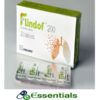Rupatrol 10mg Tablet 1pcs
৳ 12.00
Indications
Therapeutic Class
Pharmacology
Rupatadine is a second generation, non-sedating, long-acting histamine antagonist with selective peripheral H1 receptor antagonist activity. It further blocks the receptors of the platelet-activating factor (PAF) according to in vitro and in vivo studies.
Rupatadine possesses anti-allergic properties such as the inhibition of the degranulation of mast cells induced by immunological and non-immunological stimuli, and inhibition of the release of cytokines, particularly of the tumor necrosis factors (TNF) in human mast cells and monocytes.
Dosage & Administration
Rupatadine Tablet: The recommended dosage is 10 mg once daily, with or without food.
Rupatadine Oral Solution (Children aged 2 to 11 year):
- Children weighing 25 kg or more: 1 teaspoonful (5 ml) of oral solution once daily with or without food.
- Children weighing equal or more than 10 kg to less than 25 kg: 1/2 teaspoonful (2.5 ml) oral solution once daily with or without food.
Interaction
Contraindications
Side Effects
Pregnancy & Lactation
Precautions & Warnings
Use in Special Populations
Elderly: Rupatadine should be used with caution in elderly. No information is available that indicates the requirement of any dose adjustment in this population.
Children: Neither the safety nor the efficacy of Rupatadine has been established in patients less than 12 years of age.
Patients with renal or hepatic insufficiency: Use of Rupatadine is not recommended in patients with renal or hepatic insufficiency. As no relevant clinical data is available.
Brand
Square Pharmaceuticals Ltd














